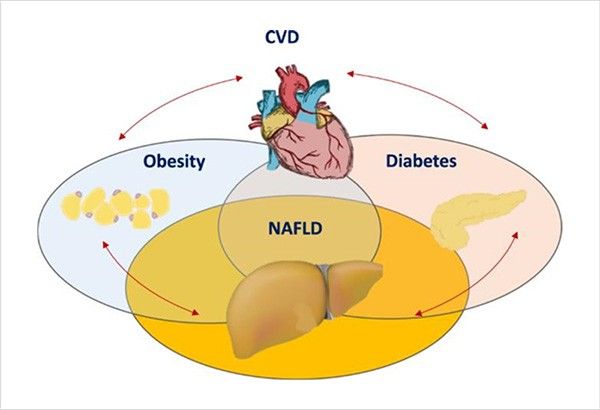Deadlier type of Fatty Liver Disease increasing in the Philippines — doctors

MANILA, Philippines — As the immediate threat of the COVID-19 pandemic begins to fade and a semblance of normalcy returns, the need to prioritize one’s health and staying vigilant is amplified.
Unfortunately, not all epidemics are predictable, and some have been prevalent for years without ever being detected.
Non-Alcoholic Fatty Liver Disease (NAFLD) or otherwise called “Fatty Liver Disease” has emerged as a significant health concern. As the most common liver disease worldwide, it affects an estimated 38% of the world’s population and is continuing to increase. In the Philippines, 10-20% of the population have NAFLD, and 18 million more who are considered obese and overweight are at risk of developing the disease.
“NAFLD is an important disease today and in the future. This is a disease that could be a challenge to the world,” said Dr. Jose Sollano, Hepatologist and Professor of Medicine at the University of Santo Tomas (UST).
With NAFLD being one of the most common liver diseases in the Philippines according to the Global State of Liver Health Report published by the Global Liver Institute, and dubbed as the silent epidemic, the disease continues to sweep through the population undetected, causing complications and even death to unsuspecting patients.
“In the shadow of a silent threat, we are concerned about the alarming risk of NAFLD among Filipinos, a risk that is met with a concerning lack of awareness. We must empower every Filipino and mostly, individuals who live with Type 2 Diabetes, Obesity, and/or Cardiovascular conditions with information about NAFLD and fostering a culture of proactive health management,” said Dr. Yvonne Ferrer, Sanofi Consumer Healthcare ASEA Medical Head.
What is NAFLD?
NAFLD is a medical condition characterized by the accumulation of excess fat in the liver often seen in people who are overweight or obese. When not caught early or when not managed properly, NAFLD could lead not only to liver diseases, but also cause cardiovascular diseases.
The condition exists on a spectrum, ranging from simple fatty liver (steatosis) to Non-Alcoholic Steatohepatitis (NASH)—a more severe form that causes inflammation and potential liver damage. In advance cases, NAFLD can lead to fibrosis, cirrhosis, and even liver failure or cancer.
Genetics, lifestyle, environment, and microbiota all have a role in NAFLD. While obesity may be an obvious factor in the development of NAFLD, other factors like Diabetes and Metabolic Syndrome can also contribute to it. There is also a subset of NAFLD patients referred to "lean NAFLD" who are not overweight but do present with the disease.
In the Philippines, NAFLD has gained attention due to its increasing prevalence, mirroring the global trend. In fact, 11.9% of Filipino NAFLD patients were classed with "lean NAFLD," making this sub-condition frequent in Asian populations.
“40-48% of the population of the Asia Pacific region have lean NAFLD, which means they are neither diabetic nor obese, yet they have the Metabolic Syndrome. This type of NAFLD has higher morbidity and mortality,” said Dr. Diana Payawal, Immediate Past President of the Philippine College of Physicians and Scientific Advisor to the Global State of Liver Health 2022.
Data from the National Institutes of Health suggest that the country’s transition to a more sedentary lifestyle, unhealthy dietary habits, and the rising prevalence of obesity and Diabetes have contributed to the escalating incidence of NAFLD.
Battling NAFLD
NAFLD is a difficult disease to control when it comes to both prevention and management. While there are medications that are supposedly directed to treating NAFLD, evidence is yet to show if they are effective.
“Even medications like Semaglutide, which is recommended to aid weight loss and in turn manage NAFLD, is not an ideal treatment as it is not accessible to most people and its usage outside of managing diabetes or obesity is already being questioned,” Dr. Aurora Macaballug, Endocrinologist and Vice President of the Philippine College of Endocrinology, Diabetes, and Metabolism remarked.
Given the challenges of controlling the disease, experts agree that one of the best ways to address and prevent this silent epidemic is through the practice of proper self-care, wherein individuals make conscious choices about their diet and overall lifestyle.
According to Dr. Payawal, hitting just one symptom of NAFLD won’t be enough, “Since it is a mitochondrial and multi-factorial disease, we need to hit different aspects of the disease in order to control it.”
Timely detection of the disease to prevent irreversible damage is essential for proper self-care, and ultrasound, specifically Fibro scan, is one of the best non-invasive methods for diagnosing fatty liver.
Individuals must also undergo necessary tests (count of enzymes, ultrasound, Fibro scan) and follow a healthier diet to lose weight and reduce alcohol intake.
Apart from adopting a healthy diet and essential tests, Dr. Limuel Abrogena, Family Physician and Member of the National Board of Trustees of the Philippine Academy of Family Physicians (PAFP), stresses the value of familial support in preventing NAFLD saying, “For example, when a patient needs to go on a diet, we encourage the other family members to join in, so the patient doesn’t feel left out.”
“Understanding the disease is one thing, but preventative measures hold the key to curbing the disease’s prevalence and impact on public health. By fostering a culture of self-care and making conscious choices, people can take control of their liver health and contribute to a healthier future for the country,” Dr. Ferrer concluded.




















